
22 minute read
Section 1: Politics before the War
THE HOME RULE CRISIS, 1912–1914
On the eve of the First World War, it looked like a civil war was going to break out in Ireland. Nationalists and Unionists were divided over the issue of Home Rule which sought to re-establish a Parliament in Dublin. Propaganda, including postcards featuring political cartoons, was produced by both sides. Unionists feared the religious and economic consequences of Home Rule because they knew that a self-governing Ireland was bound to be dominated by Catholics. On ‘Ulster Day’ (28th September 1912), Unionists attended services in Protestant churches before signing the Ulster Solemn League and Covenant or Women’s Declaration, to show their opposition to Home Rule. In south Armagh 4,941 individuals signed the documents, while in south Down 13,299 signed.
Advertisement
In 1913 both sides went a step further and formed their own private army. The Unionists established the Ulster Volunteer Force (UVF) in January 1913 and the Nationalists reacted by forming the Irish Volunteers in November 1913. While the UVF was set up almost immediately in Newry and Mourne it was not until
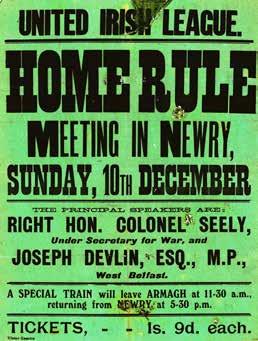
Poster advertising a Home Rule meeting in Newry, 1911 (© Armagh County Museum Collection)
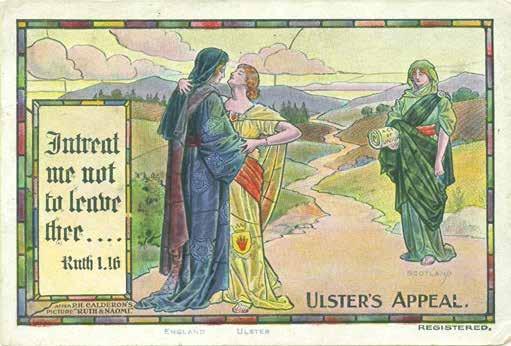
Postcard produced by Unionists in 1912 as part of the Anti-Home Rule campaign. The image on the postcard is modelled on the pre-Raphaelite P. H. Calderon’s painting of the biblical figure, Ruth (Ulster), leaving her adopted mother, Naomi (England). The figure representing Scotland holds a scroll entitled ‘Act of Union’ (Newry and Mourne Museum Collection)

May 1914 that the Irish Volunteers began to appear in the district. By July 1914 County Armagh had 7,600 men in the Ulster Volunteer Force and 5,400 men in the Irish Volunteers. By early 1914, around 3,000 women from across Ulster had enlisted in the UVF and served as nurses, typists and postal workers, as well as in the signalling section. Nationalist women joined the constitutional Ladies’ Auxiliary of the Ancient Order of Hibernians (AOH), established in 1910, and Cumann na mBan, set up in April 1914, acted as a female wing to the Irish Volunteers.
The UVF, in April 1914, successfully smuggled into Larne, Bangor and Donaghadee, arms purchased in Germany and these were distributed throughout Ulster. The Irish Volunteers carried out a similar gun-running at Howth, near Dublin, in July 1914.
WOMEN’S SUFFRAGE
Suffrage, the right for women to vote in parliamentary elections, gained momentum in the years prior to the outbreak of the First World War. The first Irish suffrage society was formed in Belfast in the early 1870s by Isabella Tod. Initially, peaceful and constitutional methods were used but by the early twentieth century some of the women involved began to use more assertive and extreme tactics, including arson, window-breaking and bombing. Much of the militant activity in Ulster tended to be restricted to Belfast and its immediate hinterland but in February 1913 an attack was carried out on the letterbox at Newtownhamilton Post Office in County Armagh.
A suffrage society was established in Newry in December 1911 and by May 1913 it had 48 members. By the same date Warrenpoint Suffrage Society, which predated the one in Newry, had 58 members. Both the Newry and Warrenpoint societies were affiliated to the non-militant Irish Women’s Suffrage Federation (IWSF). In 1912 the IWSF established a Northern Committee to co-ordinate the activities of its northern societies and Dora Mellone, a leading suffragist in Warrenpoint, was appointed as

Members of the South Down UVF marching through Kilkeel (Courtesy of PRONI, D2638/D/49/145)
its secretary. Also notable in the suffrage campaign was Dr Elizabeth Gould Bell. Dr Bell was born at Springhill House, Altnaveigh, near Newry, in 1862. She was the first female medical graduate in Ireland, graduating from the Royal University of Ireland in 1893. After qualifying, she set up a medical practice in Belfast and was a member of both the Irish Women’s Suffrage Society and the Women’s Social and Political Union, which had been set up in Manchester in 1903 by the Pankhursts. In 1911 Dr Bell travelled to London and was arrested and imprisoned for breaking windows during a suffrage demonstration. Thirteen women were arrested for militancy in Ulster between March and August 1914. Dr Bell worked as a doctor for the suffragettes who were imprisoned in Crumlin Road Gaol in Belfast.
The First World War interrupted and then brought great changes to both Home Rule and women’s suffrage.

CLASSROOM ACTIVITIES
THE ULSTER COVENANT AND WOMEN’S DECLARATION
1. Look at the text of the Covenant and answer the following questions:
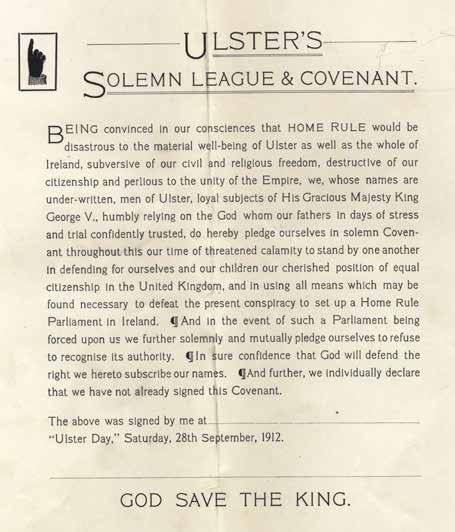
Text of the Ulster Solemn League and Covenant (Newry and Mourne Museum Collection)
• Identify four reasons why Unionists did not want Home Rule? • What action did the Unionists pledge to take if Home Rule was forced on Ireland? 2. The following is the text of the Women’s Declaration:
We, whose names are underwritten, women of Ulster, and loyal subjects of our gracious King, being firmly persuaded that Home Rule would be disastrous to our Country, desire to associate ourselves with the men of Ulster in their uncompromising opposition to the Home Rule Bill now before Parliament, whereby it is proposed to drive Ulster out of her cherished place in the constitution of the United Kingdom, and to place her under the domination and control of a Parliament in Ireland.
Praying that from this calamity God will save Ireland, we hereto subscribe our names.

• How does the text of the Women’s Declaration differ from that of the Covenant signed by the men? Why do you think this might be?
HOME RULE PROPAGANDA
3. This is an example of a postcard produced as propaganda during the Home Rule crisis.
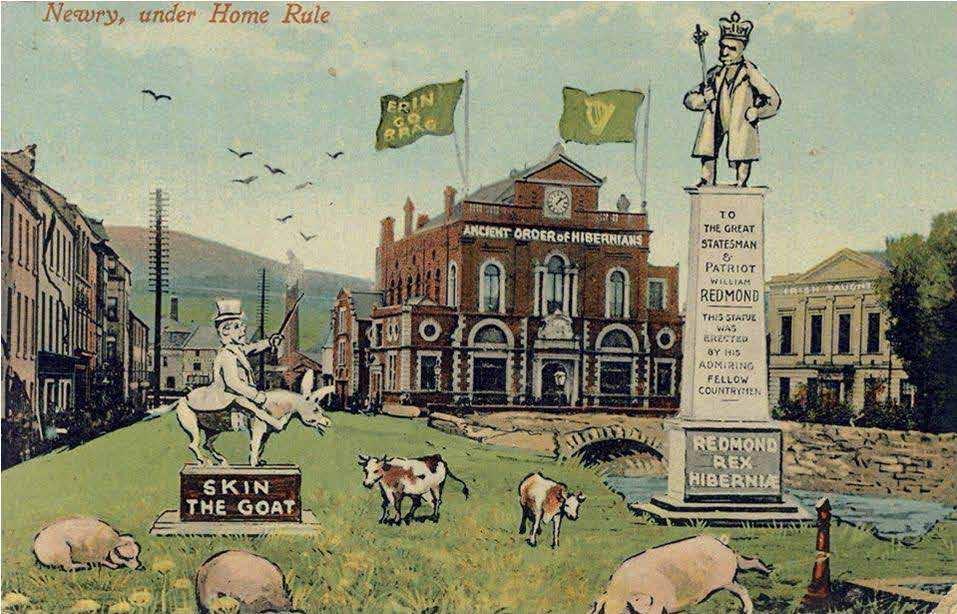
Home Rule postcard (Courtesy of David Elliott)
• Study the postcard and identify three negative consequences for Newry if Home Rule is introduced.
• What has the Town Hall become the headquarters for? • What is now taught at the Municipal Technical School? • What images are used to suggest the backwardness of the economy under a Home Rule parliament? • Do you think this postcard was designed to be pro-Home Rule or anti-Home Rule? 4. Use the Internet to see if you can find other political postcards or cartoons that were produced during the Home Rule crisis.

THE VOLUNTEERS AND THE HOME RULE CRISIS
5. Look at the following images of the Ulster Volunteer Force and read the report of the Police
Inspector for County Down.
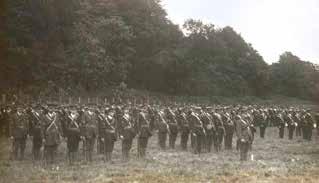
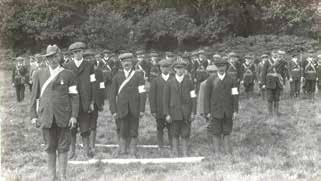
Images 7 & 8: Photographs of members of the 2nd Battalion South Down Regiment of the UVF at Mourne Park, near Kilkeel (Courtesy of PRONI, D2638/D/150, /153)
Report of the Police Inspector for County Down on Unionist marches held in Kilkeel and Newry, during September 1913 (Courtesy of the National Archives, Kew, CO 904/91)
On the 17th Sept. Sir E. Carson & other Unionist leaders, held meetings at Kilkeel & Newry. At the former, 950 volunteers were inspected in the presence of 4,000 people, and at the latter, 600 volunteers in the presence of 8,000 spectators. […]
The quiet determined look of these […] partially drilled men, as they marched through the street and roads to the several meetings, made a great impression on even some advanced Nationalists who witnessed it. It was also a matter of much comment, the number of volunteers who wore war medals, and of men whose military bearing showed that they had been old soldiers or militiamen. The presence of large employers of labour in the ranks side by side with their employees was also a noticeable feature.
• Do the men in the UVF depicted in the photographs look like a military force? Explain your answer.
• What do the sources suggest about the level of organisation, discipline and training within the volunteer movement?
• What evidence is there that men of different social classes served in the UVF?
• What impression did UVF parades make on Nationalists in Newry? 6. The following is a letter written by an Englishman who visited Kilkeel in July 1914. The letter was printed in The Down Recorder on 25th July 1914.
The population [of Kilkeel] is fairly evenly divided between the Church of Rome and Protestantism, and until recently old-time animosities had been dying out. Neighbours forgot religious differences in the mutual offices of friendship. When on ‘the Twelfth’ a Protestant family went to the ‘Orange walk’ it was a Romanist neighbour who fed the poultry and watered the cattle. If the too vigorous beating of the Nationalist drum had burst the skin the Orange Lodge was at hand to lend its instrument till repairs could be effected. When work was over of an evening the young men foregathered at the street corner without religious or political cleavage. Orange and Green drank together in perfect amity on the evening of St. Patrick’s Day.
But within the last few years a change has passed over the spirit of Kilkeel. The imminence of Home Rule has revived antagonisms which were passing into forgetfulness. Kilkeel supplies its

contingent to the Ulster Volunteers. It was at Annalong, a few miles round the coast, that some 50 field guns, so report affirms, were landed a few weeks ago. Four destroyers of the Royal Navy steam to and fro within sight of shore. Forgetfulness is no longer possible.
The young men still meet together when the day’s work is done, but now in two groups. There is no open hostility. Intercourse is still civil; but it is increasingly rare. Neighbours, who once stood to gossip when they met, now give each other good-day and hasten on their several ways. The spirit of the place has changed.
One evening I strolled into the town to see for the first time a muster of the Ulster Volunteers. […]
The whole Protestant population of the neighbourhood lined the street to see the troops march out of town – old men, women, children. There was no cheering, no applause, no laughter, no movement save on the part of those who sought some more favourable position to view the scene. The tense silence in which the crowd looked on was one of the most impressive features of an incident which I shall never forget.
• How does the writer describe the atmosphere in the district at this time? • What does it suggest about neighbour relations during the Home Rule crisis? How did this vary from what they were like before the crisis? 7. Read the following police reports from May 1914 (Courtesy of the National Archives, Kew, CO 904/93):
County Armagh: The present uncertainty of the political situation is undoubtedly affecting business and trade. There is no speculation. The building trade is at a standstill […]. Shopkeepers are badly hit and do not get the same credit as formerly from the wholesale firms. [...] The outlook in general is considered very bad.
County Down: Party feeling continues to grow and is now more bitter than ever; there is an increase in the number of drills held by the Ulster Volunteers; the present state of political uncertainty is gravely affecting trade; the building trade is at a stand still; linen merchants not being able to guarantee the fulfillment of contracts are losing business which will be hard to recover.
• According to these police reports what impact did the Home Rule crisis have on the local economy? 8. The following article is taken from The Manchester Guardian, 27th May 1914:
THE NATIONALIST FORCE IN ULSTER:
The maintenance of peace in Newry last night is one of the most striking instances of the success of the Ulster Nationalists’ efforts to persuade their people not to express outwardly their gratification at the passing of the Home Rule Bill. For some reason which is not ascertainable the Unionists worked themselves into a state of panic. They make no secret of the fact that they feared an attack by the Catholics, who are in a large majority in the town, and at night the Ulster Volunteers placed pickets armed with revolvers at the approaches to Protestant streets. Despatch riders linked up the picket parties with two Newry companies which had been marched outside the town, and also with detachments drawn from surrounding villages. Happily this ostentatious display of martial force was ignored by the Nationalists, and some seven hundred members of the National Volunteer companies were kept drilling in their own quarters well away from the danger of a collision. The authorities expect no trouble now.

Newry has a reputation (in which it takes some pride) for demonstrations and occasional shindies. Near the centre of the town, indeed, is an island lamp which in the eyes of the police authorities limits the territory of each section. In the population of 13,000 there are 9,000 Catholics, who control the Urban District Council, and they have 1,500 Volunteers enrolled, while the Ulster force in the town numbers only 900.
• Despite the rivalry, how does this source suggest that both forces were disciplined and leaders sought to avoid conflict where possible? • Can you find evidence of recognised areas in the town for each side? 9. This is a photograph of Rev. Samuel Mayes. Rev. Mayes was rector of Creggan Church of Ireland from 1908 to 1916. He lived in the Glebe House, Crossmaglen. In 1912 he signed the Ulster Covenant at Clarkesbridge. He was one of the organisers of the UVF in Crossmaglen. He later served as a chaplain during the First World War.
Can you find Rev. Mayes in the online 1911 Irish Census and then answer the following questions?
• How many sons had Rev. Mayes in 1911? • How many servants did he have? • What religion were the servants? Does this surprise you? 10. The following is taken from a witness statement provided to the Bureau of Military History by John McCoy of south
Armagh (Courtesy of the Irish Military Archives):
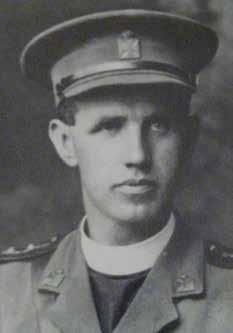
We had a local Company [of the Irish Volunteers] organised which I joined. We had no rifles or other military equipment. We did not possess in our ranks even a competent military instructor. We had a preponderance of man-power from men of advanced years who wished to give the Movement their approval down to boys just after leaving school. Arms drill was carried out with pitchfork and shovel handles. There did not seem to be much efficient direction either in the local organisation of the Volunteers or in their efforts to set up a progressive drilling and training scheme. Our absolute deficiency in arms made our efforts at training seem unreal and not worth the effort. Some time about July or early August 1914 we heard that rifles were to be distributed to a number of South Armagh Companies and that we would get our share. […] I remember waiting up through all a summer’s night when I heard that the rifles were actually on their way to us in the hope that if the supply was limited that I at least would get one. I had no clear idea in my mind at this time, if arms were made available, against whom we should use them. I could not then visualise their use against the Ulster Volunteers as I had many good friends amongst young Unionists in Newry and district.
Rev. Samuel Mayes (Courtesy of Creggan Church of Ireland Select Vestry)
• How does this source suggest that prior to July 1914 the Irish Volunteers were poorly equipped? • How useful is this source for gaining an insight into why the Irish Volunteers were formed and the types of activities they engaged in?

11. In the following extract from Patrick Casey’s witness statement to the Bureau of Military
History, Patrick describes growing up in Newry as a young teenager during the Home Rule crisis. He was later a member of the IRA (Courtesy of the Irish Military Archives)
I attended the Christian Brothers Schools at Kilmorey St, then at the Abbey, and finally at the “Car Stands” or St. Margarets in the centre of the town of Newry. Some of my mentors were Brothers Murray, Hayes, Grainger, Quinn, Gleeson, Geoghegan, and Mr. Peter McCann, B.A. From an early age – (9 or 10) – these men did more than anything else to influence and mould my outlook in the national ideal. Peter McCann was an extreme nationalist and a keen student of the Irish language of which he was a fluent speaker. He was a man of high ideals who had no time for the corrupt party politics of the early 1900’s.
During the period 1912-13, the district from whence I came was in a state of turmoil; this was the town of Newry and, being so located between Orange and Green, one was virtually in the middle of the forces of reaction and those engaged in the fight for freedom.
• What did Casey remember as being key influences on the development of his political views?
12. The following witness statements to the Bureau of Military History were provided by John
McCoy, from south Armagh, and Patrick Rankin, from Newry (Courtesy of the Irish Military
Archives)
John McCoy: The active propagandists for Sinn Fein were few in number. In fact I do not think there was one person in our parish trying to propagate the new movement. In the towns of Dundalk and Newry there might be to my knowledge about a dozen in each trying hard to make an impression on the lukewarm supporters of the parliamentarians. The Gaelic League at this time was very active and had classes organised in almost every parish and their influence had much more effect than the strange new departure which Sinn Fein advocated.
Patrick Rankin (a member of the Irish Republican Brotherhood): Very little progress was made during these years 1907 to 1913 […] Things in Newry and district were very low […] The people did not seem to care about such things, and there did not seem to be any meetings of these organisations.
• How much support do the witness statements suggest Sinn Féin and Republicanism had in the Newry and south Armagh area in the years before the First World War?
THE HOWTH GUN-RUNNING
13. The following is taken from a report written by Sir John Ross on the Howth gun-running. A Catholic, Sir John Ross was Chief
Commissioner of the Dublin Metropolitan Police. He had a house at Rostrevor.
At about 3 p.m. on Sunday 26th July 1914 when about to leave my house for the afternoon I received a report from the Supt. Headquarters to the effect that some 2,000 rifles were landed at Howth on that day, in open daylight and about 1,200 National Volunteers were now marching towards Dublin with them; that the R.I.C. and Military had been informed and that three tram-car loads of Police were going to intercept them, also that communications were being made to the Military [….]

Shortly before 5 p.m. news reached me that there had been a collision between the party under the Assistant Commissioner and the
Sir John Ross (Newry and Mourne Museum Collection)

Volunteers; but as usual the report was accompanied by an exaggerated rumour, in this case it having been said that one of the soldiers had been so badly hit he was dying or was already dead.
That afternoon I tendered my resignation to His Excellency.
• How many Nationalists were involved? • What happened in the evening after the landing of the arms?
WOMEN IN PRE-WAR POLITICS
14. Examine the following sources about women in the Home Rule crisis.
Extract from an article in The Daily Graphic, 28th September 1912:
THE SOCIAL SIDE OF THE ULSTER CAMPAIGN
The beautiful seat of the Earl of Kilmorey, situated in the valley of the Mourne Mountains, was the scene of one of the biggest social functions in the Ulster campaign. […]
The Countess of Kilmorey […] received the guests on the garden terrace. She was accompanied by the Earl of Kilmorey and her son, Viscount Newry and Mourne. All Unionist members of Parliament and their speakers were invited, and the residents of the County Down and immediate neighbourhood. Refreshments were served in a large marquee and on small tables beneath the trees, while a band played selections during the afternoon.
Extract from a County Armagh police report, February 1914 (Courtesy of the National Archives, Kew, CO 904/92):
Ambulance classes have been held in a great many places at which elementary instruction has been given and a great many women & girls have given in their names promising to give their services if required.
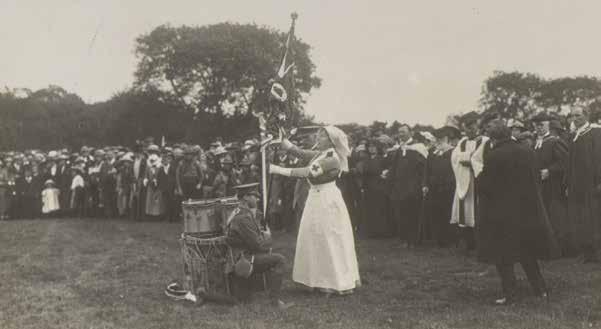
Photograph of the Countess of Kilmorey presenting the Mourne Companies of the South Down Regiment of the UVF with a flag, August 1914 (Courtesy of PRONI, D2638/D/49/153).
During the presentation ceremony Lady Kilmorey made a short address to the Volunteers: “Men

of Mourne, I am very pleased to present to you this day this flag which stands for freedom and loyalty to our King. Into your hands and safe keeping I give it, knowing you are to be trusted. Let the knowledge that you form part of the greatest empire in the world give weight to your right arms and firmness to your hearts.” (Quoted in The Newry Reporter, 4th August 1914).
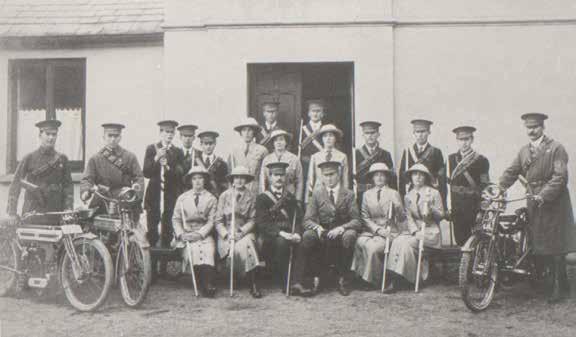
Photograph of UVF Dispatch Riders and Signallers attached to the South Down Regiment (Courtesy of PRONI, D2638/D/49/152).
The UVF set up Signalling and Dispatch Riding Corps to replace the regular Post Office and thus minimise intelligence breaches. The lady signallers practised regularly from the high parts of the Mourne Mountains, sending messages by use of flags and lamps.
• Using the sources above to help you, what ways were women able to demonstrate their opposition to Home Rule? • How might some of these activities have prepared women for the First World War? • How does the extract from The Daily Graphic suggest that there was a social aspect to the
Ulster Unionist opposition to Home Rule? • The photograph of the UVF signallers and dispatch riders includes three individuals with the surname Mackintosh. Use the online 1911 Irish Census to find out the relationship between Anne (Annie), Henry (Harry) and Lillie Mackintosh. What age were they in 1911?
What jobs did they do? Where did they live? What church did they attend? 15. Look at the following sources on local women involved in the suffrage movement. Extract of a speech made by Dr Elizabeth Bell at a suffrage meeting held in Newry on 21st
March 1911 (Reported in The Frontier Sentinel, 25th March 1911):
Women have been asking for enfranchisement for over forty years […] For nearly forty years women used none but constitutional methods; they held drawing-room meetings, public meetings, sent petitions, resolutions, got promises of support from members of Parliament, got Bills in Parliament which even passed the second reading but ended there – no practical result.

Do you wonder that some women decided to try other tactics? Whatever may be the opinion of those present to-night as to the methods employed to further women’s suffrage, it can hardly be denied that militant tactics have brought the question before the general public in a way that forty years of constitutional agitation had utterly failed to achieve. The most encouraging sign of progress is the general feeling that our political recognition is bound to come.
Article in The Irish Citizen (19th April 1913), written by Mrs Coade, Honorary Secretary of the Newry Suffrage Society:
We have Generals many, leaders of proved mettle and worth, but not one among them all who can command the whole of our women’s forces, and lead us in solid union on to victory. Our sore and trying need is for a commander in chief. We present the sad spectacle of a disunited army.
View of Dora Mellone of Warrenpoint Suffrage Society expressed in Votes for Women, 19th
September 1913:
The north of Ireland at the present, is not in the mood to be affected by broken windows or threats of disturbed meetings. Such attempts would merely end in the temporary defeat of the suffrage movement. Rightly or wrongly, the north just now is prepared to risk more than broken windows for the sake of its political creed and men who are prepared to face civil war are not afraid of a burnt house or two.
• From the report on Dr Bell’s speech, how long did she say women in Ireland had been seeking the vote? • How, and for what reasons, did Dr Bell suggest the tactics used to campaign for the women’s vote had changed over time? • How does Mrs Coade suggest the suffrage campaign was weakened by divisions and a lack of overall leadership? • How do Dr Elizabeth Bell and Dora Mellone differ in their views on the effectiveness of militant tactics in the suffrage campaign? 16. The following is an extract taken from the suffrage newspaper, The Irish Citizen, 22nd
March 1913:
SPORADIC MILITANCY?
It has transpired that an outrage, attributed to some person who is in sympathy with the Suffragist propaganda, was committed at Newtownhamilton, Co. Armagh, Post Office on the night of 23rd or morning of 24th [February]. On Monday morning the post-mistress found that a quantity of black fluid, presumably ink, had been poured into the letterbox since the previous day. Fortunately the box had been cleared of letters, and no injury was done, but the police authorities are prosecuting strict inquiries into the matter.
• What happened in Newtownhamliton in February 1913 as part of the wider suffrage campaign? • Why do you think suffrage supporters attacked the postal system?




